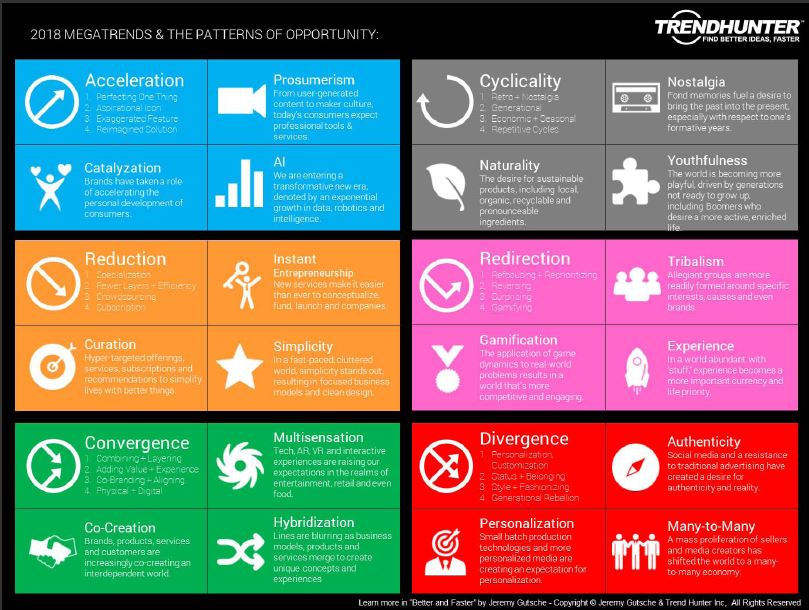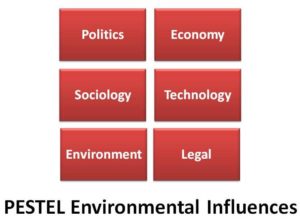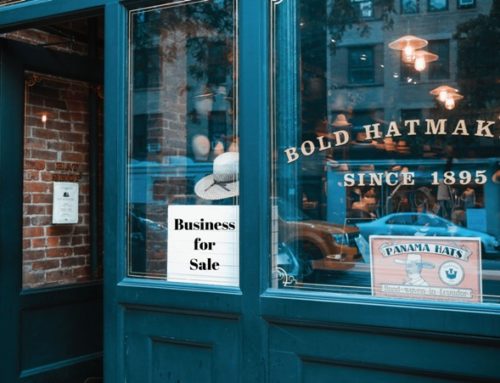
‘Designing Strategies’ eNewsletter
May – June 2018 Volume 15 – Issue 83
Being aware of what is happening around you – and your small business – on a regular basis is critical to your success. Far too many small businesses get blindsided by changes coming their way. They may not be paying attention or fail to ‘read the tea leaves’ correctly. Or, they may have a smug feeling of invincibility, believing nothing can take them down. Those who fall into one or more of these categories, soon find themselves out of business. Remember: trends and changes are important to the success or failure of your small business. They can help you move forward or hurt your chances of growth and success.
 Remember the story about the guy who made excellent buggy whips? He failed to recognize he was really in the ‘transportation’ industry and that automobiles would soon replace horse-drawn buggies and carriages. Eastman Kodak and Polaroid both missed major changes coming in photography.
Remember the story about the guy who made excellent buggy whips? He failed to recognize he was really in the ‘transportation’ industry and that automobiles would soon replace horse-drawn buggies and carriages. Eastman Kodak and Polaroid both missed major changes coming in photography.
The need for film and film developing disappeared, as did the need for instant, mediocre quality photographs. Digital imaging took over, leaving them in the dust, struggling to get back their share of the market. Blockbuster Video used to charge membership fees to rent video tapes. Changes in technology and rapid growth of the Internet knocked Blockbuster out of the running with new online video delivery services. Not keeping up with technological changes in their industry hurt them in a big way.
The Influence of External Changes
Just how much influence these external changes can have depends on several factors. The industry you practice in, the products or services you offer, and your customer base are a few. Any business, in any industry, needs to remain keenly aware of external changes that can – and will – affect their ability to operate a successful small business. Internal changes are easier to see and control as they are right in front of our eyes. External changes are outside and come from different categories. They can sneak up on you if you aren’t paying attention.
 Influences like a really bad economy can, and do, bury quite a few small and even large businesses in a short period of time. Think about how the US economy was affected in the time frame following September 11, 2001. After the World Trade Center buildings fell, people just stopped spending money. They were in shock. Suddenly, adding unnecessary ‘things’ became unimportant to Americans. Things previously considered important suddenly were shelved or pushed to a back burner.
Influences like a really bad economy can, and do, bury quite a few small and even large businesses in a short period of time. Think about how the US economy was affected in the time frame following September 11, 2001. After the World Trade Center buildings fell, people just stopped spending money. They were in shock. Suddenly, adding unnecessary ‘things’ became unimportant to Americans. Things previously considered important suddenly were shelved or pushed to a back burner.
Dealing with an Economic Downturn
In 2008-09, the economy took another nose dive that many were not prepared for. Massive changes were going on that most were prepared for. The crash went so deep that it took a number of years to bring the economy back. Small businesses struggled to stay alive as long as possible. Many were just not prepared or financially stable enough to stay afloat until recovery came about.
One of my astute interior design clients not only managed to stay afloat during the recession, she was able to double their pre-recession revenues. What did she do? Actually, she switched to a pretty simple strategy: she went where the money was. During the economic downturn in the US and other global markets, the Japanese market remained in pretty good shape. She opened a second office on the West Coast to place them strategically closer to Japan. The time required for multi-stop flights from her main office to Japan was cut, saving time and money. With these changes,she focused on the overseas market where spending was still relatively strong.
A second strategy was to expand their customer base and seek government work. We all know that even when taxpayers don’t have money to spend the government always seems to have plenty of ours to use. While she did not enjoy having to act as the ‘banker’ for government projects – only receiving payment after total project completion – she was able to keep her staff working. When several of her staff had to quit, she did not replace them. These three strategies led her firm to more than doubling their revenues from before the Recession hit.
In the Fall of 2016, we published a newsletter highlighting mega trends occurring in 2017 according to a report by Trendhunter. To begin your own environmental awareness, below are the mega trends they predicted for 2018. The full 2018 report, can be yours in exchange for a little bit of contact information. When you consider this report normally costs $1,500 and you can get it FREE, a little bit of contact information is a pretty low cost.
Mega Trends for 2018
Trendhunter identified the same six MegaTrends for 2018 as they did for 2017:
- Acceleration
- Cyclicality
- Reduction
- Redirection
- Convergence
- Divergence

How mega trends and changes evolved from 2017 to 2018
Although the six mega trends remained the same, the Patterns of Opportunity have changed. Download your own copy of the report to analyze how these patterns can affect your business and what opportunities you can take advantage of. In the mean time, let’s take a look at a few changes coming our way according to a couple of Mega Trends identified in Trend Hunters’ 2018 Report.
Cyclicality
 Cyclicality effects and results in trends like Nostalgia, Naturality, and Youthfulness. We are still operating with attention to different generations, their wants and needs. As Boomers age into retirement, they look back longingly to their youth. Back in the times that things were less stressful and a lot more fun. They want to recapture the fun of their youth. Summer camps and travel experiences for adults are springing up. This time, the camps come without counselors and with ‘adult beverages’ included.
Cyclicality effects and results in trends like Nostalgia, Naturality, and Youthfulness. We are still operating with attention to different generations, their wants and needs. As Boomers age into retirement, they look back longingly to their youth. Back in the times that things were less stressful and a lot more fun. They want to recapture the fun of their youth. Summer camps and travel experiences for adults are springing up. This time, the camps come without counselors and with ‘adult beverages’ included.
With the Eco-boom still going strong and supported by the younger Millennial generation, more products are being launched using local foods and materials, recycled materials. Customers are looking for foods with natural ingredients that they recognize and can pronounce. Companies embracing an ecological approach to producing products using recycled materials are doing well by marketing these changes to their customer base.
Reduction
If you watch cable TV or read trending articles on the Internet, you may already be aware of the increase in Reduction as a mega trend. “Tiny homes” are becoming popular options for Millennials to get their own homes. Cities use them as a solution to homelessness. The cost per home is much lower and many of  the housing units can be easily moved from place to place. Limiting the amount of ‘stuff’ they can accumulate is either a perk or a drawback. It is up to the owners to decide. And, don’t forget expensive, luxury ‘extra rooms’ in the form of tree houses as well as these tiny homes.
the housing units can be easily moved from place to place. Limiting the amount of ‘stuff’ they can accumulate is either a perk or a drawback. It is up to the owners to decide. And, don’t forget expensive, luxury ‘extra rooms’ in the form of tree houses as well as these tiny homes.
Not surprisingly, Millennials don’t want all the rooms in homes their parents had. Formal living rooms and dining rooms are not on their list of ‘must haves’ for a home. Additionally, not just Millennials want smaller, more efficient and portable living arrangements. Baby Boomers are also looking for smaller living quarters. There is a massive clean out of years of accumulated ‘stuff’ to prepare for moving to smaller quarters. And, Generation X, and some Millennials face aging parents moving in with them. Tiny homes in their backyards are good solutions to have Mom or Dad live close by, but separately. The need for smaller, more compact furnishings and multi-purpose goods for these homes will grow.
Business Perspective of Reduction Trend
From a business perspective, Reduction results in smaller, specialized businesses operating under a model to reduce the distance between prospects becoming customers. Reduction of layers within a company puts less distance between customers and company leaders. Further, the shorter distance between a customer introducing their problem to getting a solution. Simplicity is a key concept for the Reduction trend. Simplify your company processes to get your specialized products and services into the hands of customers. Make it easier for them to do business with you.
Scan External Trends and Changes for Your Strategic Management Process
Major potential disruptions to your small business are everywhere. Remember, keep an eye open to new trends and changes that can affect, or completely bury your small business. There are half a dozen external areas small businesses need to be aware of to keep moving forward smoothly. Those areas are open to drastic quick changes or slowly introduced change. You can remember what they are easily by remembering PESTEL – the first letters of the six most common external areas of influence.

How attuned are you to external environmental changes going on in the world? Many external trends and changes can affect every small business, yours included. But, some can offer you opportunities that were not available before. Pay attention! Watch what changes are going on. Be aware, consider how external changes might affect your business both short and long term. Keep your eyes on these changes and plan how you will embrace them and adapt. Your future success depends on it.
Visualize – Analyze – Strategize







